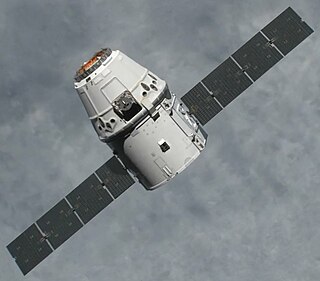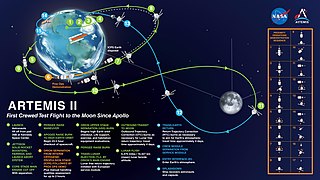Related Research Articles

Ariane 5 is a retired European heavy-lift space launch vehicle operated by Arianespace for the European Space Agency (ESA). It was launched from the Guiana Space Centre (CSG) in French Guiana. It was used to deliver payloads into geostationary transfer orbit (GTO), low Earth orbit (LEO) or further into space. The launch vehicle had a streak of 82 consecutive successful launches between 9 April 2003 and 12 December 2017. Since 2014, Ariane 6, a direct successor system, first launched in 2024.

ELA-3 is a launch complex at the Guiana Space Centre in French Guiana. The complex was first used in June 1996 in support of the now retired Ariane 5 rocket. It is currently being refurbished to support Vega E launches. The complex is 21 square kilometres (8.1 sq mi) in size.
ProtoStar Ltd was a private company incorporated in Bermuda, with U.S. operations based in San Francisco, California and Asian operations based in Singapore. ProtoStar intended to operate an initial fleet of three geostationary satellites. Two satellites were acquired and launched. ProtoStar's anchor customer, Dish TV India Limited, is the largest direct-to-home television operator in India.
The DirecTV satellite fleet is a group of communications satellites located at various geostationary orbits that DirecTV uses for their satellite television service and HughesNet internet service. The "DirecTV" prefix in their names has been changed to "T".
Eutelsat 4A, previously Eurobird 4A and Eutelsat W1 is a French communications satellite which is operated by Eutelsat. It was constructed by Astrium is based on the Eurostar-2000+ satellite bus. Its launch was contracted by Arianespace, using an Ariane 4 44P-3 carrier rocket. The launch occurred on 6 September 2000, at 22:33 UTC from ELA-2 at the Guiana Space Centre.
Eutelsat 113 West A, formerly Satmex-6, is a geostationary communications satellite which is operated by Eutelsat. Originally built for Mexico's Satmex, it was launched in 2006. The satellite was acquired by Eutelsat in its 2014 merger with Satmex, and renamed Eutelsat 113 West A in May. It is used to provide communications services to the Americas, Hawaii and the Caribbean.

The year 2012 saw a number of significant events in spaceflight. In May and October, the first Commercial Orbital Transportation Services resupply missions took place, during which the SpaceX Dragon became the first private spacecraft to dock with the International Space Station (ISS). In June, China launched the crewed Shenzhou 9 orbital mission, and North Korea achieved its first successful orbital launch in December. 2012 also saw China's first successful asteroid exploration mission, and the landing of NASA's Curiosity rover on Mars. The Vega and Unha-3 rockets made their maiden flights in 2012, while the Proton-K made its last.

Several new rockets and spaceports began operations in 2016.

This article documents notable spaceflight events during the year 2019.

Notable spaceflight activities in 2017 included the maiden orbital flight of India's Geosynchronous Satellite Launch Vehicle Mark III on 5 June and the first suborbital test of Rocket Lab's Electron rocket, inaugurating the Mahia spaceport in New Zealand. The rocket is named for its innovative Rutherford engine which feeds propellants via battery-powered electric motors instead of the usual gas generator and turbopumps.

This article documents notable spaceflight events during the year 2018. For the first time since 1990, more than 100 orbital launches were performed globally.
Eutelsat 21B, previously known as Eutelsat W6A, is a French communications satellite. Operated by Eutelsat, it provides direct to home broadcasting services from geostationary orbit at a longitude of 21.5 degrees east. It replaced the Eutelsat 21A spacecraft which was launched in 1999.

Ariane 6 is a European expendable launch system developed for the European Space Agency (ESA) and manufactured by a consortium of European companies, led by the prime contractor ArianeGroup. As part of the Ariane rocket family, it is operated by Arianespace, replacing the Ariane 5. The project’s primary contributors were France (55%), Germany (21%), and Italy (7.6%), with the remaining work distributed among ten other participating countries.
Intelsat 33e, also known as IS-33e, was a high throughput (HTS) geostationary communications satellite operated by Intelsat and designed and manufactured by Boeing Space Systems on the BSS 702MP satellite bus. It was the second satellite of the EpicNG service, and covered Europe, Africa and most of Asia from the 60° East longitude, where it replaced Intelsat 904. It had a mixed C-band, Ku-band and Ka-band payload with all bands featuring wide and C- and Ku- also featured spot beams.
Intelsat 36, also known as IS-36, is a geostationary communications satellite operated by Intelsat and designed and manufactured by Space Systems/Loral on the SSL 1300 satellite bus. It covers Sub-Saharan Africa and South Asia from the 68.5° East longitude, providing media and content distribution with the South Africa MultiChoice company as anchor customer. It has a mixed C-band and Ku-band.

This article documents expected notable spaceflight events during the year 2026.
References
- ↑ Henry, Caleb (16 January 2018). "Ariane 5 down to two dozen launches before Ariane 6 takes over". SpaceNews . Retrieved 30 January 2018.
- ↑ "Press kits Archive - Arianespace". Arianespace. Archived from the original on 1 April 2018. Retrieved 3 April 2018.
- ↑ Krebs, Gunter. "Eutelsat W3B, W3C, W3D / Eutelsat 3D, 16A". Gunter's Space Page. Archived from the original on 13 April 2018. Retrieved 29 November 2017.
- ↑ "Ariane 5 Suffers Rare On-Pad Abort after Engine Ignition – Spaceflight101". spaceflight101.com. Spaceflight 101. 5 September 2017. Archived from the original on 16 March 2018. Retrieved 16 March 2018.
- ↑ "Azerspace/Africasat-1a is prepared for Arianespace's first Ariane 5 launch in 2013". Archived from the original on 29 August 2018. Retrieved 29 August 2018.
- ↑ Dorimulu, Primus (20 June 2016). "BRI Launches BRISat: First Satellite Owned and Operated by a Bank | Jakarta Globe". Jakarta Globe. Archived from the original on 16 March 2018. Retrieved 16 March 2018.
- ↑ Clark, Stephen (30 January 2017). "Intelsat satellite in service after overcoming engine trouble – Spaceflight Now". spaceflightnow.com. Spaceflight Now. Archived from the original on 26 June 2018. Retrieved 3 February 2018.
- ↑ Henry, Caleb (1 September 2017). "Intelsat-33e propulsion problems to cut service life by 3.5 years - SpaceNews.com". SpaceNews.com. Space News. Retrieved 3 February 2018.
- ↑ Krebs, Gunter. "Sky-Brasil 1 (Intelsat 32e)". space.skyrocket.de. Gunter's Space Page. Archived from the original on 5 February 2017. Retrieved 16 March 2018.
- ↑ "A rocket's launch from French Guiana has been delayed indefinitely due to protests". The Verge. 23 March 2017. Archived from the original on 23 March 2017. Retrieved 23 March 2017.
- ↑ Clark, Stephen (2 June 2017). "Ariane 5 succeeds in launch of two high-value communications satellites – Spaceflight Now". spaceflightnow.com. Spaceflight Now. Archived from the original on 26 June 2018. Retrieved 16 February 2018.
- ↑ Clark, Stephen. "Two high-power broadband satellites set for record-breaking launch on Ariane 5 rocket – Spaceflight Now". spaceflightnow.com. No. 1 June 2017. Spaceflight Now. Archived from the original on 26 June 2018. Retrieved 16 February 2018.
- ↑ Henry, Caleb (15 February 2018). "Viasat says ViaSat-2 business plan intact despite antenna glitch - SpaceNews.com". SpaceNews.com. Space News. Retrieved 16 February 2018.
- ↑ Clark, Stephen (9 September 2017). "Electrical problem prompted Ariane 5 countdown abort – Spaceflight Now". spaceflightnow.com. Spaceflight Now. Archived from the original on 10 March 2019. Retrieved 16 March 2018.
- 1 2 3 "VA240 Launch Kit" (PDF). Arianespace. Retrieved 14 June 2018.
- ↑ "Independent Enquiry Commission announces conclusions concerning the launcher trajectory deviation during Flight VA241 - Arianespace". Arianespace. Archived from the original on 23 February 2018. Retrieved 23 February 2018.
- ↑ "Launch VA241: Ariane 5 delivers SES-14 and Al Yah 3 to orbit". Arianespace. Archived from the original on 26 January 2018. Retrieved 27 January 2018.
- ↑ Clark, Stephen (26 January 2018). "Probe into off-target Ariane 5 launch begins, SES and Yahsat payloads healthy – Spaceflight Now". spaceflightnow.com. Spaceflight Now. Archived from the original on 6 May 2018. Retrieved 16 March 2018.
- ↑ Payer, Markus (26 January 2018). "SES-14 in good health and on track despite launch anomaly". SES. Archived from the original on 28 January 2018. Retrieved 21 March 2018.
- ↑ Forrester, Chris (12 March 2018). "YahSat to make 50% insurance claim". advanced-television.com. Advanced Television. Archived from the original on 21 March 2018. Retrieved 21 March 2018.
- ↑ de Selding, Peter B. (20 March 2018). "Yahsat expected to file $108-million insurance claim following bad Ariane 5 launch". Space Intel Report. Archived from the original on 6 March 2019. Retrieved 6 March 2019.
- ↑ Bergin, Chris (5 April 2018). "Ariane 5 to return with DSN-1/Superbird-8 and HYLAS 4 – NASASpaceFlight.com". www.nasaspaceflight.com. NASASpaceflight.com. Archived from the original on 6 April 2018. Retrieved 5 April 2018.
- 1 2 3 4 "VA242 Launch Kit" (PDF). Arianespace. Retrieved 19 April 2018.
- ↑ "Superbird 8 / DSN 1 – Ariane 5 VA242 | Spaceflight101". spaceflight101.com. Spaceflight 101. Retrieved 2 May 2018.
- ↑ Clark, Stephen (3 July 2018). "Arianespace aims for busy second half of 2018". Spaceflight Now. Archived from the original on 14 July 2019. Retrieved 4 July 2018.
- ↑ "Launch delay for VA243" (Press release). Arianespace. 24 April 2018. Archived from the original on 22 June 2018. Retrieved 26 May 2018.
- 1 2 3 4 "VA243 Launch Kit" (PDF). Arianespace. 17 September 2018. Retrieved 25 September 2018.
- 1 2 "100th Ariane 5 launch a success, orbiting two satellites for Intelsat, SKY Perfect JSAT and Azercosmos". Arianespace. 25 September 2018. Retrieved 27 September 2018.
- ↑ "Flight VA243: The 100th Ariane 5 will carry Horizons 3e and Azerspace-2/Intelsat 38 for Intelsat, SKY Perfect JSAT and Azercosmos". Arianespace. Retrieved 26 January 2022.
- 1 2 3 "VA244 Launch Kit" (PDF). Arianespace. 25 July 2018. Retrieved 25 July 2018.
- ↑ "Flight VA244: Arianespace's Ariane 5 launch for the Galileo constellation and Europe". Arianespace. Retrieved 26 January 2022.
- ↑ Clark, Stephen (29 April 2015). "Arabsat contracts go to Lockheed Martin, Arianespace and SpaceX". Spaceflight Now. Archived from the original on 23 August 2018. Retrieved 7 February 2019.
- ↑ Bergin, Chris (5 February 2019). "Ariane 5 launches Hellas-Sat-4/SaudiGeoSat-1 and GSAT 31". NASASpaceFlight . Archived from the original on 7 February 2019. Retrieved 6 February 2019.
- 1 2 3 4 5 6 "VA247 Launch Kit" (PDF). Arianespace. 29 January 2019. Retrieved 4 February 2019.
- 1 2 "Arianespace orbits two telecommunications satellites on first Ariane 5 launch of 2019". Arianespace. Retrieved 5 February 2019.
- 1 2 Clark 2019 , "The two payloads bolted to the top of the Ariane 5 are the T-16 satellite, a broadcasting spacecraft originally ordered by DirecTV before its acquisition by AT&T, and the Eutelsat 7C video relay station, both heading for positions in geostationary orbit more than 22,000 miles (nearly 36,000 kilometers) over the equator."
- ↑ Bergin 2019 , "The launcher carried a total payload of approximately 10,594 kg."
- 1 2 3 Rabie 2019 , "Both satellites safely arrived in geostationary transfer orbit in a relatively short amount of time. DirecTV 16 was the first to separate from the rocket's upper stage at approximately 28 minutes after liftoff, and it was followed by Eutelsat 7C six minutes later."
- ↑ Trefis Team (27 July 2015). "AT&T Closes DirecTV Acquisition: Reviewing The Concessions And Benefits". Forbes . Archived from the original on 20 June 2019. Retrieved 20 June 2019.
AT&T closed its $49 billion acquisition of satellite television provider DirecTV on Friday, after the Federal Communications Commission ratified the deal.
- ↑ Finley, Klint (24 July 2015). "AT&T-DirecTV Merger Creates World's Largest Pay TV Company". Wired . Archived from the original on 22 April 2018. Retrieved 20 June 2019.
AT&T says that the merger makes the company the largest provider of pay television services in the world with 26 million US subscribers.
- ↑ Selyukh, Alina (25 July 2015). "AT&T, DirecTV complete merger to form biggest pay-TV company". Reuters . Archived from the original on 20 June 2019. Retrieved 20 June 2019.
The company said it will serve more than 26 million U.S. customers and more than 19 million in Latin America, making it the world's biggest pay-TV company.
- ↑ Clark 2019 , "But there are still plenty of customers subscribing to AT&T's pay-TV offerings. As of the end of March, AT&T's DirecTV and U-verse services had 22.4 million subscribers."
- ↑ Ecuer et al. 2019, "Built by Maxar Technologies, the 3.4 tonne satellite will serve markets across Africa, Europe, the Middle East and Turkey through 49 36-Mhz equivalent Ku-band transponders.".
- ↑ Bergin 2019 , "By almost doubling capacity over Sub-Saharan Africa, from 22 to 42 transponders, EUTELSAT 7C will have room for several hundred additional digital channels to support the region’s fast expanding TV market."
- 1 2 Bergin 2019 , "It will also be equipped with a beam providing enhanced capacity for government services over Europe, the Middle East and Central Asia, as well as a steerable beam that can cover any region visible from 7° East."
- 1 2 Lewis, Wendy (21 March 2016). "SSL selected to provide powerful all-electric satellite to Eutelsat". SSL . Archived from the original on 21 June 2019. Retrieved 21 June 2019.
EUTELSAT 7C is based on the SSL 1300 platform [...] It will exclusively use electric propulsion for orbit raising as well as station keeping and will provide service for a minimum of 15 years. All-electric satellites provide efficient solutions for satellite operators by reducing launch mass while retaining payload performance.
- 1 2 Henry 2019 , "The 6,330-kilogram T-16 satellite, built by Airbus Defence and Space, separated from the rocket's upper stage 28 minutes later, followed by the 3,400-kilogram Eutelsat-7C satellite from Maxar Technologies 34 minutes after liftoff".
- ↑ Ecuer et al. 2019, "EUTELSAT 7C, Eutelsat Communications' (Paris:ETL) newest high-power broadcast satellite, has arrived at the European Spaceport in Kourou, French Guiana...".
- 1 2 3 Rhian, Jason (20 June 2019). "Under Increasing Pressure from SpaceX, Arianespace Launches Telecommunications Satellites". Sapceflight Insider. Retrieved 1 January 2023.
- 1 2 Clark, Stephen (20 June 2019). "Live coverage: Ariane 5 successful in dual-payload launch from French Guiana". Spaceflight Now. Retrieved 21 June 2019.
Plus+9 minutes, 15 seconds. The main cryogenic stage's Vulcain engine has cut off and the spent stage has separated. It will fall back into the atmosphere into the Atlantic Ocean in the Gulf of Guinea off the west coast of Africa. [...] This upper stage engine is about seven minutes into a planned 16-minute burn. [...] Plus+25 minutes, 20 seconds. The rocket's second stage shut down as scheduled.
- ↑ Ecuer et al. 2019.
- ↑ Ecuer et al. 2019, "The satellite will go into full commercial service at the end of 2019 following all electric orbit raising and in orbit tests".
- 1 2 Clark 2019 , "Thursday’s launch will be the 104th flight of an Ariane 5 rocket, and the second Ariane 5 flight this year. It will be the fifth mission of the year for Arianespace..."
- ↑ Krebs, Gunter D. "Ariane-5ECA+". Gunter's Space Page. Retrieved 9 July 2024.
- ↑ Henry, Caleb (26 November 2019). "Ariane 5 launches satellites for Egypt, Inmarsat". SpaceNews . Retrieved 26 November 2019.
- ↑ "Arianespace to launch Inmarsat's fifth Global Xpress satellite". Arianespace. 27 October 2017. Archived from the original on 27 October 2017. Retrieved 28 October 2017.
- ↑ Krebs, Gunter. "Inmarsat-5 F5 (GX 5)". Gunter's Space Page. Archived from the original on 23 November 2017. Retrieved 28 October 2017.
- ↑ "Fifth Global Xpress satellite readied for Ariane 5 launch". Arianespace. Retrieved 30 October 2019.
- ↑ "Ariane Flight VA 250 - Arianespace" (Press release). Arianespace. 26 November 2019. Archived from the original on 26 November 2019. Retrieved 26 November 2019.

